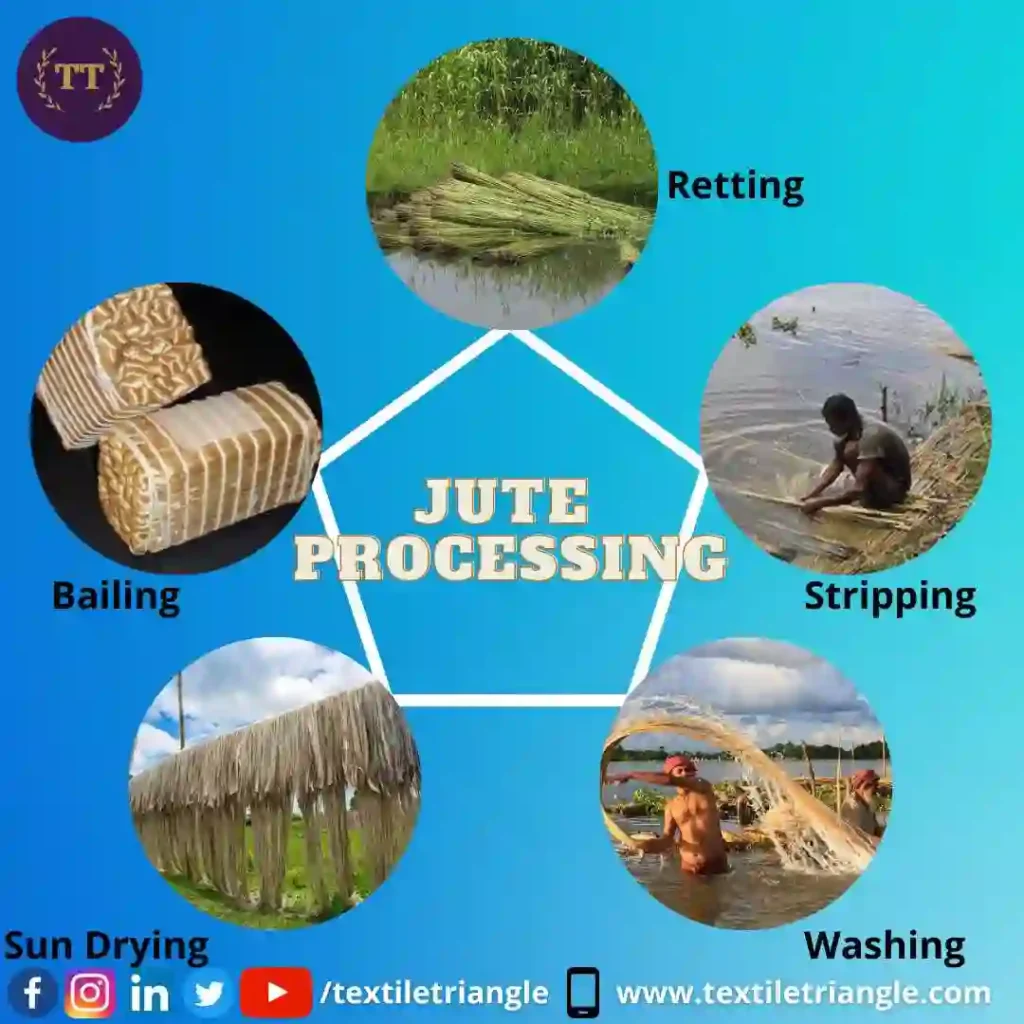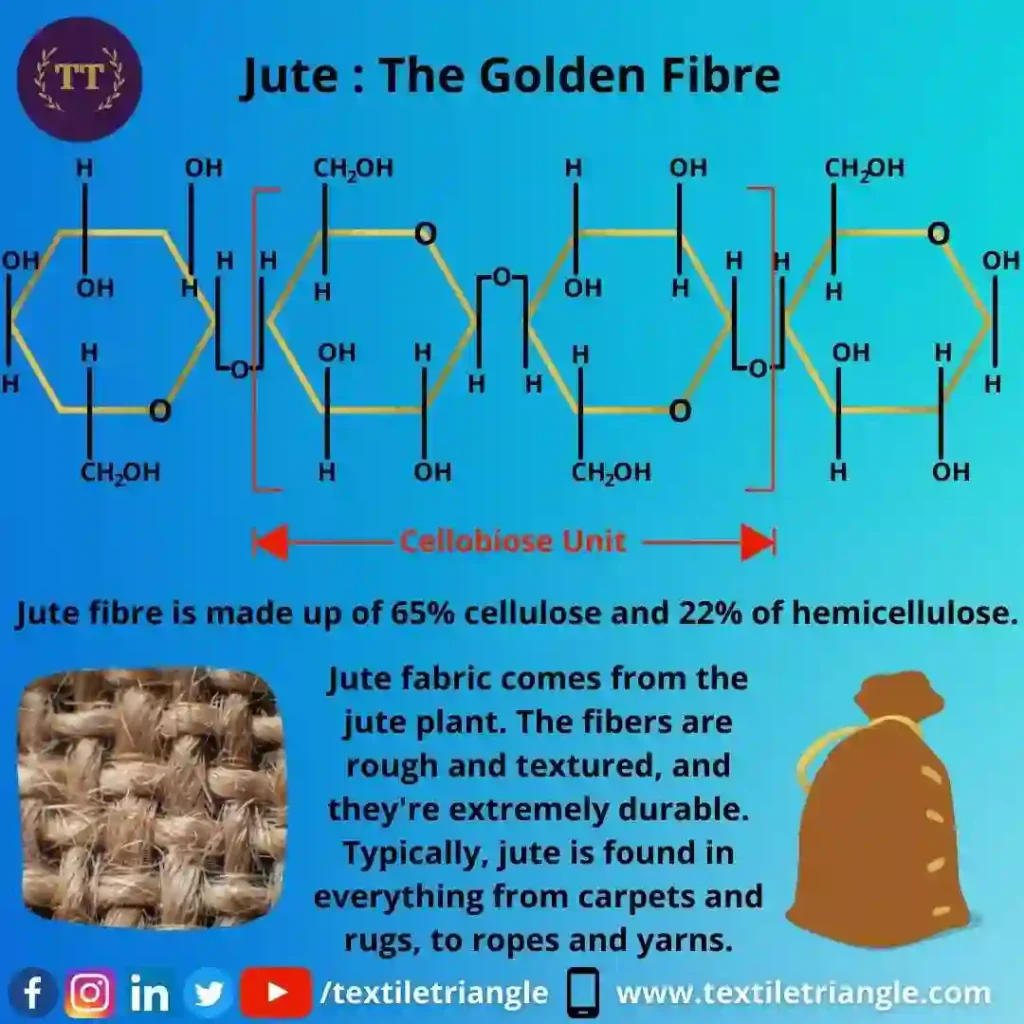Table of Contents
1. Introduction
Jute is long soft, shiny vegetable fibre that can be spun into yarn. Jute is one of the cheapest natural fibres. Raw jute in the form of bales are processed in jute mills to produce Hessian, sacking, jute yarn, bags and other useful products.
Jute is mainly composed of polysaccharides and lignin but it also contains smaller amount of fats and waxes, pectin, nitrogenous colouring and inorganic matters. As a major composition of jute, the cellulose chain molecule is the basic building unit of cell wall and formed by linear combination of a series of glucose rings. The repeat unit of cellulose molecule is known as ‘cellobiose’ residue, consisting of two glucose residues.
Jute is a vegetable fibre or plant fibre, popularly called as golden fibre due to its colour and cash value. Jute is second only to cotton in world’s production of fibres. Jute is also considered as fiber of future not only due to its biodegradable and eco-friendly nature but also its low cost and strength among all natural fibres.
2. Cultivation of Jute
Jute is primarily a monsoon crop. It grow in warm and humid climate, requires loamy or alluvial soil and standing water. It thrives best where annual rainfall ranges from 150 to 250 cm, temperature from 20°C to 40°C and 70 to 90% relative humidity.
The crop is mainly cultivated in Ganga-Brahmaputra delta and their tributaries. Sowing is done from March to early June depending on species, rainfall and type of land. Seeds are sown by broadcast or dropped in furrows or line using drills. The seed are sown closely to produce unbranched jute plants. Unlike cotton, jute does not require much of fertilizers and pesticides. In early stages, weeding is needed.
The plant matures in four to six months. It is harvested from June to September depending upon month of sowing (early or late). Early harvesting gives low yield, lack strength but white coloured fibre; whereas, late harvesting produces more yield but coarser fibres. For optimum yield and good quality fibres, it is advisable to harvest crop when half of the plants are at fruiting stage.
3. Processing of Jute
Bundlles of leafless stalks of jute, are transported from field to nearest water bodies for extraction of fibre. Stagnant water body such as pond or ditch are used for steeping the bundles. Sometime slow-running water is preferred for steeping the bundles for good Retting as stagnant water spoils the quality of fibres. To extract fibres from woody central part of the jute stem, the following steps are need to followed:
1. Retting 2. Stripping 3. Washing 4. Sun Drying 5. Bailing
Click to Read more about Jute Cultivation

4. Physical Properties of Jute
- Specific gravity: 1.48
- Specific Heat: 0.325
- Bad resiliency, Moderate abrasion resistance, Good dimensional stability
- High water holding capacity
- Low extensibility
5. Chemical Properties of Jute
- Effect of bleach: Not affected by oxidizing or reducing bleaches.
- Effect of Acids & Alkalis: Easily damaged by hot dilute or cold concentrated acids. Resistant to alkalis.
- Resistant to organic solvents.
- Scoured jute has good resistance to microorganisms and insects.
- Burns rapidly.
6. Chemical Composition of Jute
- Cellulose: 53-63%
- Hemicellulose: 22-26%
- Lignin: 11-12%
- Water Soluble: 1.5%
- Fats & Wax: 0.3%
7. Application / Uses of Jute
Jute fiber is a low cost fibre. Rough weaving of raw jute fibres are used for making various fabrics for bagging, packaging and wrapping textiles. Fibers are also used for making rope, twine and matting, and decorative fabrics, woven carpets, curtain, linoleum and oil cloth.
Frequently Asked Questions | FAQs
What is jute and what is it used for?
Jute is a long, soft, and shiny vegetable fiber that can be spun into coarse, strong threads. It is obtained from the jute plant, scientifically known as Corchorus olitorius and Corchorus capsularis, which are primarily cultivated in the Indian subcontinent and other warm, humid regions.
Jute is widely used for various purposes due to its versatility and affordability. Here are some common uses of jute:
Sacking and packaging: Jute fibers are particularly suitable for making sacks, bags, and other packaging materials. Jute bags are commonly used for carrying agricultural produce, such as grains, potatoes, coffee, and cocoa.
Textiles: Jute fibers can be blended with other natural or synthetic fibers to create fabrics. Jute textiles are commonly used for making curtains, carpets, rugs, upholstery, and various home furnishing items.
Handicrafts and decor: Jute’s natural, earthy appearance makes it a popular choice for handicrafts and decor items. It can be used for making wall hangings, lampshades, baskets, coasters, and other decorative pieces.
Erosion control: Jute mats and nets are used for erosion control in areas prone to soil erosion. They help stabilize soil on slopes, riverbanks, and construction sites, preventing erosion and facilitating plant growth.
Geotextiles: Jute fibers can be used to make geotextiles, which are permeable fabrics used in civil engineering applications. Geotextiles made from jute provide strength, durability, and resistance to biological degradation.
Agriculture and gardening: Jute fibers are used in agricultural applications, such as twines for binding plants and tree saplings. Jute bags are also used for storing and transporting agricultural inputs, such as seeds and fertilizers.
Paper and pulp industry: Jute fibers can be used in the production of paper and pulp, particularly for low-cost and eco-friendly applications. Jute-based papers are used for packaging, stationery, and other similar uses.
Jute is considered an eco-friendly and sustainable fiber due to its biodegradability, renewability, and carbon dioxide absorption properties. It is often referred to as the “golden fiber” due to its significant economic and ecological importance in various industries.
What is jute made from?
Jute is made from the fibers of the jute plant, scientifically known as Corchorus olitorius and Corchorus capsularis. The jute plant belongs to the family Malvaceae and is primarily cultivated in the Indian subcontinent, particularly in India and Bangladesh.
The jute plant is an annual crop that grows to a height of about 10 to 12 feet (3 to 3.6 meters). It has long, shiny, and coarse fibers located beneath the bark of the plant’s stem. These fibers are obtained by retting, a process in which the stems are immersed in water and then left to partially decompose. The retted stems are then beaten to separate the fibers from the non-fibrous woody part of the stem.
The jute fibers are long, soft, and golden in color. They are composed primarily of cellulose, a complex carbohydrate that provides strength and durability to the fibers. The fibers are then spun into coarse threads or yarns, which can be further processed and woven into various jute products.
Jute is considered a natural and renewable fiber as it is derived from plants and can be cultivated on a large scale. Its production requires relatively less water and chemical inputs compared to other fibers, making it an eco-friendly option in the textile and packaging industries.
Which type of crop is jute ?
Jute is classified as a bast fiber crop. Bast fibers are obtained from the inner bark (or “bast”) of certain plants, which includes jute. The jute plant belongs to the family Malvaceae and is cultivated for its fibrous stem. The long, coarse fibers of jute are derived from the stem’s bast layer.
Other examples of bast fiber crops include flax, hemp, kenaf, and ramie. These plants have been traditionally grown for their strong and durable fibers, which have various industrial and textile applications. Bast fibers are known for their strength, flexibility, and resistance to stretching, making them suitable for a wide range of uses.

